|
FAQs about Corallimorph
Identification 8
Related Articles: Corallimorpharians, Cnidarians, Water Flow, How Much
is Enough,
Related FAQs: Mushroom ID 1, Mushroom ID 2, Mushroom ID 3, Mushroom ID 4, Mushroom ID 5, Mushroom ID 6,
Mushroom ID 7, Mushroom ID 9,
Mushroom ID 10,
& Corallimorphs, Mushrooms 2, Mushrooms 3, Mushrooms 4, Mushroom Behavior, Mushroom Compatibility, Mushroom Selection, Mushroom Systems, Mushroom Feeding, Mushroom Health, Mushroom Reproduction,
Stinging-celled Animals,
|
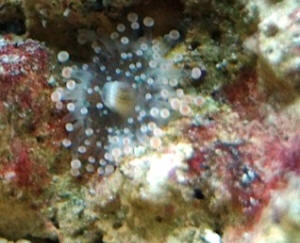
|
|
Anemone? ID
5/25/13
Hello,
<Derek>
I was wondering if you would be able to help identify the anemone in the
attached picture.
<Mmm, not just from this one pic, no>
I got it, along with some other coral in a trade and while he called it a
carpet anemone I failed to find any pictures that matched to get an
exact ID. It's doubled in size since I got it, and seems to be
doing well. Not sure if it helps, but the tentacles are not sticky
so I've not been able to feed it like I do with my BTA.
Thanks in advance.
Derek
<Can you scoot the substrate away from the pedicle and get a close,
flash pic? Bob Fenner>
|
.jpg) |
Re: Anemone ID
5/25/13
Hi Bob,
<Hey Derek>
Hopefully this one helps, but unfortunately the way it's sitting the foot is
attached to the rock and not the substrate, so I couldn't really move away
much. Not sure if it's helpful, but around the foot and when disturbed
it has some fine purple thread like tentacles that come out (see bottom left
in the pic).
<Acontian fibers perhaps>
When I originally put it into the tank, and it was fully closed, the foot
looked similar. There were so many "threads" that I thought it had
been damaged when it was removed from the original tank.
Thanks for the help. If this isn't good I'll catch it after dark when
it closes up more, and then see if I can't get a better picture. The
camera is having a hard time focusing, so I may have to get my wife (the
photographer) to put the camera in manual mode and get a better one.
I'm a auto-focus point and shoot photographer :)
Thanks,
Derek
<The strange clustering of the base of tentacles... that so many are
bifurcated is throwing me. I don't know what this is, but will look through
my references. BobF> |
.JPG) What IS this? B
What IS this? B |
Re: Anemone ID 5/25/13
Hi Bob,
<Hey Alex>
I think the "anemone" in question might be a Corallimorpharian like
Rhodactis or similar, not a true anemone.
<I do agree with you>
Cheers, Alex
<And you, BobF> |
|
Hi all! Quick question about a live rock hitchhiker...
4/10/13
First off, LOVE your site! It helped me ID quite a few hitchhikers like
Neothonidium magnum and a shy glass Cerianthid. Google helped, but you
guys were the linchpin! Thank you so much!
<Welcome!>
Ok, my question. Recently we got some live rock from Florida
and it came with the usual critters (unfortunately a few Aiptasia, but
whatevs), but there's one thing that I can't seem to identify. It looks
like a calcium carbonate free coral, about the size of a quarter,
fleshy, and moves under current, but the "dusty" quality of it and the
thick, cup-like shape of it is kinda throwing me. Also, from the
underside it has a slightly orange/pink hue. Zoanthid? Anemone?
<Mmm, well, the size and arrangement of tentacles discounts the Zoanthid
and Anemone possibilities... I think this may be a light-starved
Corallimorpharian... possibly a Ricordea. Have sent this on to LynnZ for
her input>
Also, sorry about the size of the pics. I'm doing this right before I
leave for work!
Thanks again for the awesome site!
Eric
<Thank you for being part of it, sharing. Bob Fenner>
|
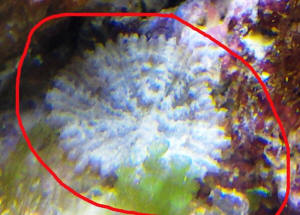
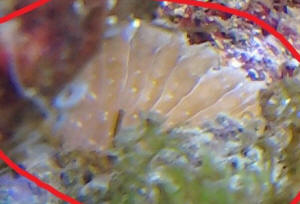 |
| Mmm, maybe, but... what is this on the right? A Foram?
Lynn... help! |
Re: Hi all! Quick question about a live rock
hitchhiker... /LynnZ–
04/10/13
Hi all! Quick question about a live rock hitchhiker...
Lynn, any idea/s? B
<Yep, I'm guessing it's a Corallimorph of some sort, possibly a bleached
Discosoma carlgreni (aka the "Forked-Tentacle Corallimorph") or Discosoma
neglecta (aka the Caribbean Umbrella Mushroom)? I'm leaning towards D.
carlgreni because of the branched appearance on the "ribs".
<<Ahh, yes!>>
Here's a link showing both spp.:
http://www.advancedaquarist.com/2002/10/inverts D. carlgreni:
http://reefguide.org/carib/forkedtentaclecorallimorph.html
Take care, Lynn Z>
<<Thank you Lynn. BobF>>
<Always a pleasure, Bob! Lynn> |
|
Strange marine thing
12/23/12
Hi, Can you identify this please. It appeared one day in my marine
tank.
I'm not sure if it is eating the purple mushroom type coral or the coral is
doing something odd. The marine tank set up in its youngest elements
is 6 months, I got a larger tank, Angela Hoynes so some of the live rock
came from that tank and some is new.
<Oh Lynn! >
|
 |
Strange marine thing
12/23/12
Oh Lynn!
<Oh, brother! Heheee - I saw this query yesterday and couldn't hit the
"back" button fast enough! It almost looks like a curled up Corallimorph of
some sort but...?? I'll go ahead and send a reply asap.
<<Oh yeah! At first glance, I'm... Uhh, is this a Prosobranch of some sort?
Mmm, don't see any sensory structures... Umm, a Cnidarian/coelenterate it
sort of reminds me of... something in my distal, way back past? Oh, best
send along to Lynn!>
How was the trip?
<Ahh, very nice. Good weather for the most part, good folks, friends to
share all with... Interesting diving, though too much BGA and reef damage to
suit me>
I bet you got some great photos to post, huh?
<A few; am thinking to post some by group on FB, Facebook... do you look at
them there?>
Can't wait to see some neat critter shots in the dailies!
<Oh yes... am a couple years ahead on the marine side currently... but you
can look/see what the archived/newer ones will be... Again, mostly only
organisms that are new to the site, or something to add to the current
depictions there of worth>
Take care,
-Lyn
<And you, BobF>
Re: Strange marine thing
12/23/12
Oh, I don't see it in the crew mail, so I'm guessing you already sent a
reply? If so, thanks!!
Happy Holidays,
-Lynn
<Oh no! Had/stuck in the emails w/ graphics folder... am moving to yours!
BobF>
fw: Strange marine thing
Oh Lynn!
<Oh, brother! Heheee - I saw this query yesterday and couldn't hit the
"back" button fast enough! It almost looks like a curled up Corallimorph of
some sort but...?? I'll go ahead and send a reply asap.
<<Oh yeah! At first glance, I'm... Uhh, is this a Prosobranch of some sort?
Mmm, don't see any sensory structures... Umm, a Cnidarian/coelenterate it
sort of reminds me of... something in my distal, way back past? Oh, best
send along to Lynn!>
<<Heeee - yep, I can relate. Like I said, I saw that thing and took
off. My last thought was that I hoped to heck that you or Jordan knew
what it was because I sure didn't!>>
How was the trip?
<Ahh, very nice. Good weather for the most part, good folks, friends to
share all with... Interesting diving, though too much BGA and reef damage
to suit me>
<<Jeez, that's so sad. Glad though, that you had a good time
otherwise.>
I bet you got some great photos to post, huh?
<A few; am thinking to post some by group on FB, Facebook... do you look at
them there?>
<<Unfortunately, no. I've been so busy that I've totally neglected
Facebook and even considered shutting it down. The good news is that
things should settle down this week after Christmas so I'll check in then.>>
Can't wait to see some neat critter shots in the dailies!
<Oh yes... am a couple years ahead on the marine side currently... but you
can look/see what the archived/newer ones will be... Again, mostly only
organisms that are new to the site, or something to add to the current
depictions there of worth>
<<I look forward to seeing them.>>
Take care,
-Lynn
<And you, BobF>
<<Thanks, Bob and Happy Holidays>>
Strange Marine Thing: Possible Corallimorph – 12/23/12
Hi,
<Hello there, Lynn here today.>
Can you identify this please.
<I’ll sure try, but no promises on this one! My first impression is that it
looks like some sort of Corallimorph that’s reacting to the other nearby
Corallimorphs by curling away from contact.>
It appeared one day in my marine tank.
<Interesting>
I'm not sure if it is eating the purple mushroom type coral or the coral is
doing something odd.
<I think it’s trying to avoid contact. What doesn’t make sense to me is why
one would suddenly appear in the middle of those that are incompatible?
Perhaps it was dislodged/floated away from its original position and somehow
ended up there? If it were me, I’d gently nudge the thing to see if it comes
loose and if so, place it elsewhere. If it doesn’t, you can either leave it
as and let the dominant organism(s) “win” or do whatever it takes to remove
the larger specimen with the understanding that it could either die or grow
back if enough is left behind. For more information regarding Corallimorphs,
please see the following link (as well as associated links listed at the
top): http://www.wetwebmedia.com/corallim.htm >
The marine tank set up in its youngest elements is 6 months, I got a larger
tank, Angela Hoynes so some of the live rock came from that tank and some is
new.
<Gotcha, thanks. If you have any other questions or problems, please let
me/us know. Take care, Lynn Z>
Re: Strange marine thing
12/24/12
Oh, I don't see it in the crew mail, so I'm guessing you already sent a
reply? If so, thanks!!
Happy Holidays,
-Lynn
<Ahh! Have just done. Thank you Lynn. BobF> |
|
anemone question or ID please - 11/15/2012Please
help if you can.... have any idea of what these are....I have attached a
crude photo.
I think baby somethings, but my strong points are not anemones. Hope
attachments come through.....if not how do we send pics.
thank you so much in advance,
Grant
<Ahh, this is actually a type/species of Corallimorpharian, Mushroom.
Please read here:
http://www.wetwebmedia.com/MushrIDF7.htm
<Cheers, Bob Fenner>
Grant C. Anderson
Curator of Fishes
The Marine Cove at Sertoma Butterfly House
4320 S. Oxbow Ave.
Sioux Falls, SD 57106
www.SertomaButterflyHouse.org
|
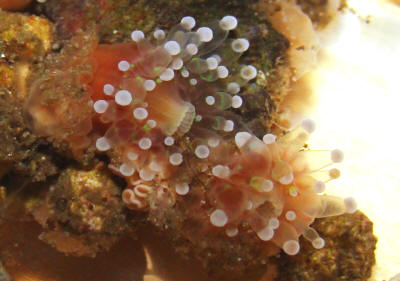 |
Re: anemone question or ID please
- 11/16/2012
thank you so much, since my accidents I have no reference to what I recall
from my earlier days.
<Yeeikes! I have an ever-diminishing recall capacity... no thanks to none!>
thank you again,
Grant
<Certainly welcome. Bob Fenner> |
|
Unidentified Anemone 11/9/12
I'm very interested in knowing what species of anemone this is. It came in a
shipment from Jakarta that I received about a week ago. It's an aggressive
eater (I'm feeding it Mysis shrimp) but it closes up under strong lighting.
The closest thing to it that I've seen is a waratah anemone (*Actinia
tenebrosa*) but I'm pretty sure that this is a different species. Any
feedback would be much appreciated.
--
*Thank you, Aaron Dragseth*
<Mmm, the tentacle ends/tips aren't "right" for Actinia tenebrosa... My
guess is that this is an aberrant Entacmaea. A beauty.
Bob Fenner>
|
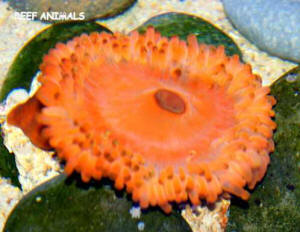 |
Re: Unidentified Anemone
11/9/12
Thank you for your feedback. I agree that it isn't an Actinia tenebrosa but
it also doesn't really look like or have the same behavior as Entacmaea
quadricolor. Are there other species of Entacmaea?
<Not as far as I'm aware... but have seen E. quadricolors look like this
from rough handling, shipping>
I actually received 3 of these anemones. They were all firmly attached to
small pieces of substrate that they have continued to cling to even a week
later. Two of the anemones
had the same foot but a completely separate set of tentacles and each had
their own oral disk. They remind me of the aggregating anemones
(*Anthopleura elegantissima*)
<Yowzah! I did a histological study of this... clone anemone... common off
of San Diego's coast... for a marine invert. class... many years ago>
that are common in my local California tide pools. .
<D'oh! That and the giant green of the same genus. Bob Fenner>
Re: Unidentified Anemone 11/9/12
I know what you mean when you say "but have seen E. quadricolors look like
this from rough handling,", I agree. The big difference on these anemones
are that they seem to be very healthy. The tentacles are very sticky, in
fact I would say that they are stickier than those on even the healthiest of
bubble-tip anemones.
Also, the foot is more like that of the our local Anthopleura species, very
leathery with an extremely strong adhesion to the substrate. An unhealthy
Entacmaea would never have such a strong hold on the substrate and the foot
is much softer. With that said, I currently have it listed for sale as a
Crimson Mystery Anemone (Actinia sp.?)
<A good name>
What do
you think?
<I do wish I were home, w/ my reference works... Am out visiting in Europe.
Maybe a (hard) run through Daphne Fautin's "Hexacorallians of the World"
(.com),
http://hercules.kgs.ku.edu/hexacoral/anemone2/index.cfm
will be productive>
LOL! It's interesting that you worked on those California Tidepool
anemones, I remember my marine biology teacher daring us to stick our
tongues in them and most of us did!
>"Squirt!"<
Would that even be legal today?!!
<Heeeee! BobF>
Help with anemone identification 11/9/12
Hello Bob, I thought that you would find this reply from Karen Sanamyan
interesting. I'm not sure if you are familiar with her or not but she is a
marine biologist at the Kamchatka branch of the Pacific Institute of
Geography, she specializes in the taxonomy of Actinaria and is one of the
authors of Actiniaria.com. It sounds like we have an
<I'll say! Thanks for sending this along Aaron. Wondered re the apparent
empty-of-tentacles space on the face, the open mouth... BobF>
Subject: Re: Help with anemone identification
11/10/12
Hello,
Well, very interesting species.
It has capitate tentacles (small spheres on the tips of the tentacles), such
tentacles usually occur in stone corals and corallimorphs, and in general
are not characteristic for true anemones (Actinaria), (except Telmatactis
and a few other Actinarian genera).
Further, on your photo I see that it has several some tentacles arranged
radially of the disk (arrows on attached photo). This feature excludes all
stone corals. Several true anemones have tentacles arranged in radial rows
(e.g. Stichodactyla), but they all are very different and have no capitate
tentacles. So, this is a Corallimorph species (corallimorphs are all
"mushrooms", e.g. Discosoma, Rhodactis, Corynactis, Ricordea and others -
you know). However, the species on your photo cannot be identified with any
known Corallimorph species, I think this is undescribed (=new) species.
Best wishes
Karen Sanamyan
http://actiniaria.com |
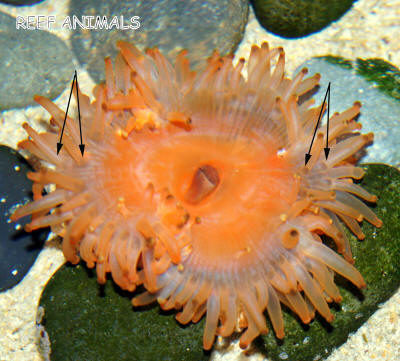 |
|
|

